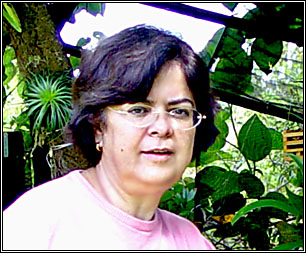 |
Maria
Rita Cabral is graduated in medicine and housewife with 4 sons
and 6 grandchildren.
She comes from the state of Minas Gerais and grew up in farms,
always loving plants in general.
At about 3 or 4 years ago, she started to cultivate orchids at
her country house in Paty do Alferes, in the state of Rio de Janeiro,
at 600 m altitude. |
|
| ON: Why
did you start to cultivate orchids? Which was the magic moment of
attraction? Have you been influenced for someone or something? |
|
MR: I had some orchids between my plants in Paty, but without
the uncontrolled passion which got me. My sons grew up giving
me more time. Reading about Delfina (may be she is found out it
now) in her site and about Érico de Freitas work, little
by little, I started to buy plants. Suddenly, I saw my self calling
D. Helga de Freitas, asking her to help me buying plants which
will be thrive and forming big clumps in Paty, in a mountainous
region of the state of Rio de Janeiro. Until now I like to have
plants forming big clumps, I use to buy cutting scion and put
them together instead of dividing (it is a kind of degeneration,
I think).
Then I took heart and asked Delfina to help me to identify plants
from which I just had |
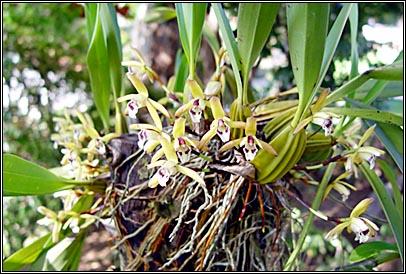 |
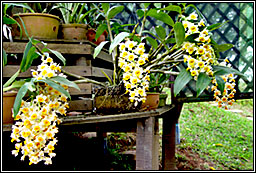 |
photos. She was very kind to me.
If I had influence, yes, I had from Érico (by his work
and by D. Helga), from Delfina, from the senior growers of the
list I participate, from my friend Apolônia Grade, from
Américo Docha, Dalton Batista, Alexandre Bicolor, Carlos
Keller, Fátima Caires, Paparelli, Vera Coellho, from my
friend Mariana de Paty. I think I will forget some very important
people but I had my first contacts with the people I mentioned
due to the kind of cultivation I chose.
|
ON: How long have you been cultivating orchids?
MR: There are at about 3 or 4 years, observing, studying, buying
many literature, learning with senior growers.
ON: Hybrids or species. If species, which one do you have more?
Among yours, do you have a favorite plant?
MR: I can't say that I don't have hybrids but 90% are, for sure,
species. I think that I have more Pleurothallis, Maxillaria,
Oncidium although I have many Bulbophyllum, Cattleya,
Bifrenaria. I would say that Maxillaria species are
my favorite, I can't resist to form a clump with them, often buying
3 or 4 small clumps and put them together. I use to say that Jorge
Luiz (Itaorchis) makes me to buy his hybrids but the species really
fascinate me. |
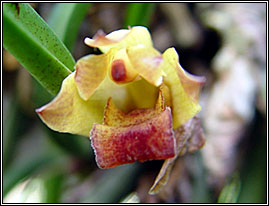
Maxillaria sp |
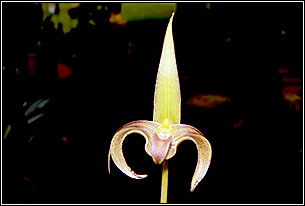
Bulbophyllum lobbii |
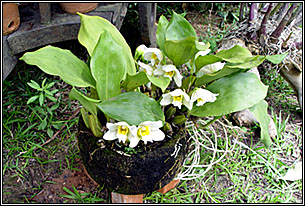
Bifrenaria harrisoniae alba |
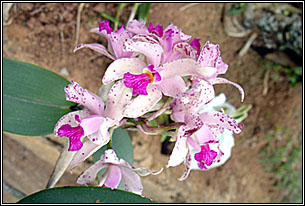
C amethystoglossa |
| ON:
How long do you spend taking care of your orchids daily?
MR: If I am in Paty, at the week-end, in general, I spent 4 or
6 hours. Here, in Rio de Janeiro, reading, participating of discussions,
at about 2 hours a day. During the vacation, I try to stay in
Paty more time in order to take care of them.
ON: How many plants do you have?
MR: At about 1200 plants, included those I should look with magnifying
glass as Carlos Henrique Paparelli says. |
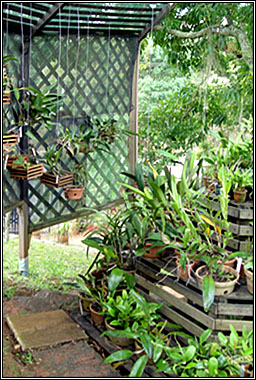 |
|
ON:
In spite of the number of plants, you don't have a nursery or
green house in a traditional means.
MR: I made a deal with my husband for not having a greenhouse.
He wanted a paysagism compatible with his ideal. So my cultivation
is all in the nature.
I have many trees with more than 30 years which are full
of orchids, planted on the trunk or hanged. Between the trees,
I put old trunks, old carriages, full of pots. |
| I
also have 3 places with stagings under the trees. I put a lot
maidenhair as well as polypodies and Platycerium dispersed
to improve the humidity. I also have wood trellis-work, with cloth
shade because, during the winter, the sun touches the side of
it and also because some trees lose their leaves during this period.
I keep the humidity of the environment watering the grass frequently.
I have a "S" shaped wire mesh under the most leafy tree
supported by pvc tube full of pebbles, fixed on the ground where
I hang the micro orchids as well as Dracula, Masdevallia,
some Pleurothallis. |
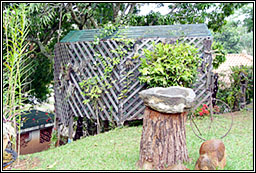 |
.
ON:
Which are the climate conditions in your place?
MR: Paty is cold as Petrópolis, however it is driest. The
winter is cold and the temperature can drop to 10º C but
it is dry. The summer is humid and the nights are fresh. During
the fall and the winter, we have morning mist. I don't lose plants
for lacking of water, I just need rains and sun alternating in
order to guarantee that the compost dries out during the summer. |
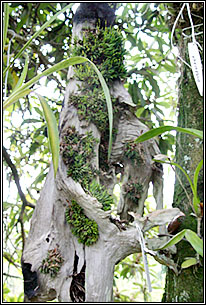
Anathallis leptotifolia on the root |
ON:
What could you tell us about fertilizer, watering, pot, com posts
and so on.
MR: I have a successful experience with open-work baskets wood
although I have many clay pots and some plastic one. The cultivation
in rock-crushed or in PET doesn't work with the gardener who takes
care of my plants during the week. With the PET, he watered too
much, watered over the leaves and I have problems with fungi while
the pots with pure rock-crushed (as many growers successfully
adopted), he watered too little. I just use rock-crush mixed to
charcoal and pine bark. As compost, I used in pots and open-work
baskets “Rendmax orquídeas e bromeliads”. Some
times, I dare with pots. |
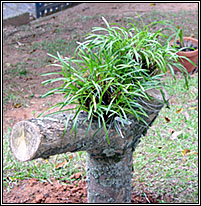 |
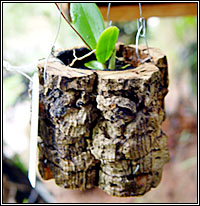
Cork as pot for micro |
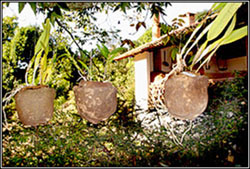
Sapucaia as pot |
For example, I use 'sapucaia' and cork, as supports or as pots.
As a pot, I perforate the "sapucaia", put pebbles and
compost inside. As a support, I put the plant outside.
I use the cork bark as support or I put two together and made
a pot for micro orchids. I also use to get or to buy old trunks,
beautiful roots and plant orchids on them. I have an old root
with more than 10 different Catasetum, it looks like one
but when it is blooming, we clearly see that there are many gathered
plants. I have a root with Anathallis leptotifolia that
I really love. I fertilize with “Peter’s” intercalating
weekly blooming and grown formula. This month, I started to use
the fertilizer Durigan which drops the PH allowing a better absorption.
Each three month, I apply bocashi. |
ON:
And the control of cultural ailments?
MR: As all plants are outside, they are exposed to insects so
I use, preventively, “Neem I Go” weekly. I could use
it fortnight but, I do in this way in order to be sure that all
plants are receiving the product. If the housekeeper applies the
product in a hurry, it could not get every plant, if he applies
weekly, there is a chance that the plants missing one week will
receive the product in the week after. This product is a mixed
of Neem oil, garlic, red pepper, karanja oil, urucum (annatto
- Bixa orellana) and artemisia (Chrysanthemum parthenium).
It has fungicide, insecticide even viricide affects so I have
little problems with insects and fungi. I use a 1% dissolution
at the end of day. It is a natural product, it doesn't harm animals
such birds I have in my back yard.
ON: With this cultivation outside and plants spread over the garden,
which is the solution you find to make the watering easier?
MR: I did a watering system using PVC tube with sprinkling which
goes up covered by coconut fiber between the trees. I just use
it during the winter to guarantee more humidity. During the summer,
in order to avoid the housekeeper waters too much, we keep it
closed. I try to control the humidity from Rio asking the housekeeper
the weather, if it is cold, if there is wind, which is rate of
humidity, so I can tell him if he should water or not.
ON: Is there a short or an amusing story connected to orchids
you can tell us?
MR: I met again people who I knew in my child wood and have lost
the contact, we met each other in the list of discussion about
orchids. This part of meeting people, exchange information is
very rewarded to me as well as the new friendship we make.
ON: One said that orchidophilia a soft manifestation of madness.
Have you done any "orchidophilic" insanity?
MR: I think so when I bought a Sophronitis coccinea alba,
if we think about costs.
ON: Thank you, Maria Rita
Photos: Maria Rita Cabral
Any
kind of reproduction (print, digital or anyone) of any
type of material of this site: texts, layout, photos,
images and others - is
strictly forbidden without previous written permission
of the authors. Any solicitation or information by the
e-mail: bo@sergioaraujo.com |
|
|